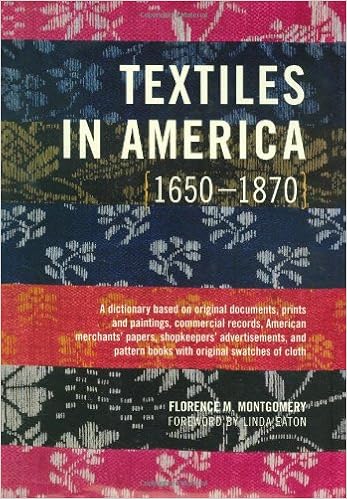Textiles in America by Florence M. Montgomery
I put off writing this one for a while, on account of the scope of this book. It's massive: a veritable encyclopedia of over two centuries worth of fabric. The book has two distinct sections: first, an overview of furnishings from the mid-17th to mid-19th centuries. The second portion is a massive glossary of fabric terms, which is decidedly a reference volume, and not meant for reading straight through.
The first portion (about 140 pages) deals with British and American textile furnishings: in general room overviews first, then with specific focus on bed draperies, curtains, and upholstery. Period images, designs, and surviving examples are used liberally throughout.
The main appeal of this book, in my opinion, is it's 238-page Fabric Dictionary. The fabrics are arranged alphabetically, by their most common name (with cross references for related fabrics, alternate names, and types). So, when you come across an unfamiliar term in your period reading, like Clara Solomon mentioning her "barege dress" in her 1862 diary, Textiles in America will helpfully provide that this is "a dress material of gauze weave with a worsted warp and silk weft." The gauze entry will further clarify that "a thin light, transparent fabric woven in a crossed-warp technique" is meant. While only a few of the entries have pictures adjacent to the descriptions, most include quotations from period sources to help provide dates as well as price, usage or design information. Depending on the information available, one entry may range from a single sentence up to an entire page. Alternative spellings or names are included for many of the fabrics. Entries on textile finishing processes are also included, such fulling and copperplate or woodblock printing. Images within the dictionary are black and white; sixty pages of color plates are included between page 140 and 141.
Textiles in America quotes extensively from original sources over two centuries, including textile references from the period, store ledgers, and letters. It also does a lovely job of citing its sources in-line and through footnotes. The final portion is a thirty-page bibliography of primary and secondary sources, some of which are annotated.
Stars: 5
Accuracy: High, and well-cited. The year range is extensive, so check the dates when looking up a fabric.
Strongest Impression: This probably isn't the first book you want to buy for learning about period textiles for garments. Additionally, the price and size may be prohibitive to some. However, it's a wonderful reference for delving deeper into the varieties of historic textiles, and for deciphering unfamiliar fabric terms in period writings. I can see it being especially desirable for historic household furnishing or textile production enthusiasts.

No comments:
Post a Comment
Thanks for commenting!